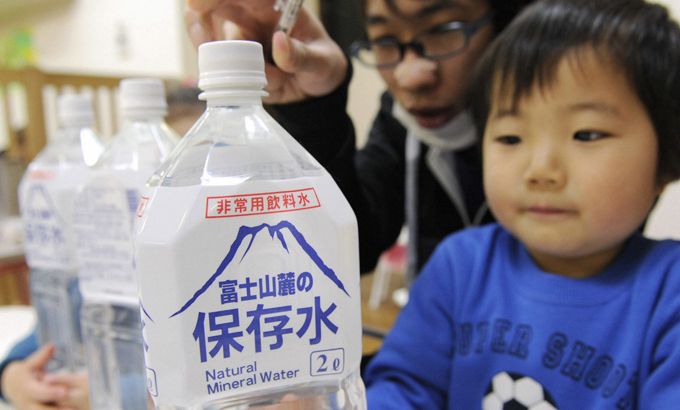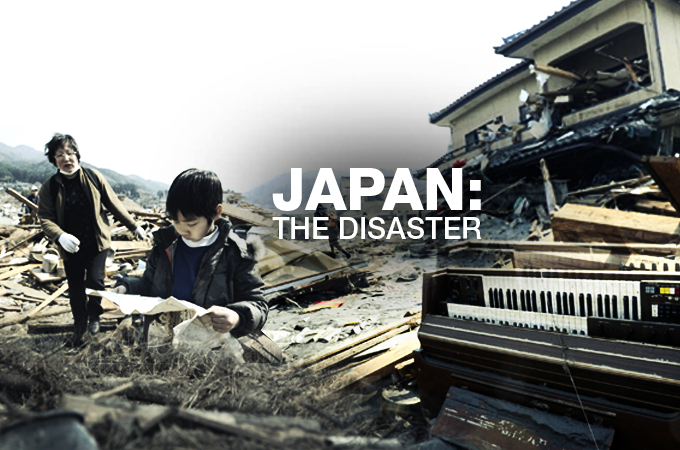Anxiety in Japan over radiation in tap water
Bottled water running low in Tokyo and thousands of people in the northeast remained without access to drinking water.

Higher than normal levels of radiation in tap water have led to a shortage of bottled water in Tokyo and thousands of people in Japan’s northeast remained without access to drinking water. Also, electricity has not been restored to at least 200,000 homes.
As the worry over water peaked, the government on Thursday said the number of people confirmed dead or listed as missing topped 26,000, 13 days after the twin disasters of earthquake and tsunami hit the country.
Keep reading
list of 4 itemsTurtles swimming to extinction in Malaysia as male hatchlings feel heat
Could shipping containers be the answer to Ghana’s housing crisis?
Thousands protest against over-tourism in Spain’s Canary Islands
The National Police Agency put the number of people confirmed to have been killed at 9,700, with a further 16,501 listed as missing. A total of 2,766 people have been listed as injured and more than 350,000 people are homeless.
Earlier, the Japanese government estimated that the damage to the country’s infrastructure and economy will top $300 billion, making it the world’s costliest natural disaster. The 1995 Kobe quake cost $100 billion while Hurricane Katrina caused $81 billion in damage.
Radiation levels above safety norms for infants were found in the water purification system in Kawaguchi, Saitama prefecture, adjacent to Tokyo.
Kawaguchi found 120 becquerels of radioactive iodine – slightly above the recommended limit. The previous day, Tokyo said it detected 210 becquerels of radioactive iodine at a water purification plant and recommended that infants not be given tap water. Becquerel is a measure of radioactivity.
However, on Thursday, Tokyo city officials said that levels of radioactive iodine in the city’s tap water had once again dropped to levels that were safe for infants.
A Tokyo official told the AFP news agency that the level had fallen back to 79 becquerels, below the 100 becquerel limit for infants and the 300 becquerel limit for adults.
The government has been distributing bottled water to residents, after store shelves were cleared of bottled water following the announcement on Wednesday.
“I’ve never seen anything like this,” said Toru Kikutaka, a Tokyo supermarket clerk, referring to his store’s empty shelves. Residents have been limited to buying up to two 2-litre bottles.
The government has appealed for calm over the fears regarding the tap water’s safety.
“We ask people to respond calmly,” said Yukio Edano, a government spokesperson, at a briefing on Thursday. “The Tokyo metropolitan government is doing its best.”
 |
| Click here to follow Al Jazeera’s special coverage |
Households with infants will get three 550-millilitre bottles of water each – a total of 240,000 bottles – city officials said.
They asked Tokyo residents to buy only what they need, in order to ensure that as many people as possible had access to safe drinking water.
Marta Ortigas, Al Jazeera’s correspondent in Morioka, reported that citizens were unsure of whether or not to trust the government’s figures on radiation.
“This does not make consumers feel any safer. At this point they no longer know what to believe, or what the reality of the true situation might be,” she said, adding that many were engaging in “panic buying”.
Meanwhile, some 660,000 households remain without water in the country’s northeast, the government said and electricity has not been restored to at least 209,000 homes as well, the Tohoku Electric Power Co said.
On Thursday, the Tokyo Electric Power Co announced that it had resumed operations at a 1,000MW thermal power plant near Tokyo, the Kyodo news agency reported. The plant, which burns Liquefied Natural Gas (LNG) had been shut immediately following the earthquake.
Work on nuclear plant
Three workers at the earthquake-stricken Fukushima Daiichi nuclear power complex have been injured by radiation, the country’s nuclear safety agency said on Thursday. Two of them have been hospitalised.
Nuclear power workers at the complex, located 220km north of Tokyo, continued on Thursday to attempt to regain control over the plant’s cooling systems, which was badly damaged during the March 11 earthquake and subsequent tsunami.
The nuclear power plant has been leaking radiation after four of its six reactors were affected by explosions and fire following the twin disasters. After worrying black smoke forced an evacuation earlier, workers are set to resume work to get the plant back to operating condition on Thursday, according to Hidehiko Nishiyama, an official with the Nuclear and Industrial Safety Agency.
They have so far partially restored power to the reactor one control room.
Radiation from the plant has caused levels of radioactive caesium and iodine in 11 different kinds of vegetables in the prefectures immediately surrounding it to skyrocket to well above normal levels, though they are still not at a stage that is considered seriously dangerous to humans.
At the Fukushima plant, officials have evacuated residents from within a 20km radius of the plant, and advised those living within 30km to stay indoors to minimise exposure.
On Wednesday the government ordered farms in four prefectures near the stricken Fukushima plant – Fukushima, Ibaraki, Tochigi and Gunma – to stop shipping a range of products due to elevated radiation levels.
Officials in six more prefectures – Miyagi, Yamagata, Niigata, Nagano, Saitama and Chiba – have been asked to step up radiation monitoring on farm products.
Concerns have spread to Europe, where in Iceland, officials said they have measured trace amounts of radioactive iodine in the air, but assured residents that they were “less than a millionth” of the levels found in the area in the wake of 1986 Chernobyl disaster.
Food import bans
On Thursday, Russia, Australia, Canada, the Phillipines and Singapore became the latest countries to restrict Japanese food imports.
The United States and Hong Kong became the first countries to restrict the imports on Wednesday, and France has asked the European Union to do the same.
The Australian ban affects food from the four prefectures immediately surrounding the Fukushima plant, and targets seaweed and seafood, milk, dairy products, fresh fruit and vegetables.
Singapore has suspended imports of milk products and other foodstuffs, while Canada has implemented enhanced import controls, both targetting exports from the same four prefectures.
The Phillipines ban affects only chocolate products, while Russia has opted to ban all food imports from the prefectures.
Al Jazeera’s Ortigas reported that the Japanese government is aiming to ensure that food that may have been affected by radiation does not leave the country.
“The Japanese government has actually said that any kind of contamination that might be found on food will not be allowed to be exported from the country … so there’s nothing for those countries to worry about, they say,” she said.
“But at the same time, there are 11 different vegetables that the Japanese government has also advised its own citizens to avoid eating, at least for the next few weeks while the contamination levels are continuing to be found in these vegetables – they include spinach, broccoli, green leafed vegetables and turnips.
“At the same time they’re saying its not harmful immediately, but prolonged use of such radioactive products could lead to danger in the future.”
A shipping industry official, meanwhile, said some merchant vessels may be avoiding Tokyo port due to concerns that crew members may be exposed to radiation.
On Thursday, Russian authorities in the Khabarovsk region placed a Panama-flagged vessel in quaratine off the coast, after radiation levels three times normal were detected in its engine room. The 19-member crew has been placed under medical supervision, Gennady Onishchenko, an official with the Russian consumer protection agency told the Interfax news agency.